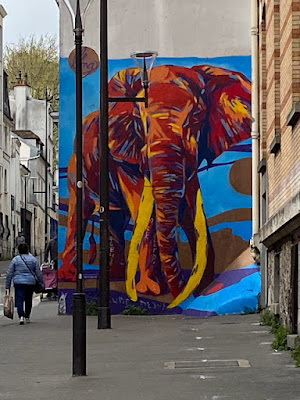 |
A mustard field in Alberta, Canada, 2021,
where most Dijon mustard seeds come from. (source) |
A few days ago in the New York Times, an article highlighted a very special problem in Paris: "the mysterious disappearance of mustard from supermarket shelves has caused, if not revolt, at least deep disquiet." Dijon mustard is irreplaceable in French cuisine, giving "edge to a steak frites, life to a grilled sausage, depth to a vinaigrette and richness to mayonnaise. " (Roger Cohen, "France Faces a Shortage of Mustard, Its Uniquely Beloved Condiment.")
 |
Leeks vinaigrette I made once: Dijon mustard is essential!
I use lots of mustard but somehow I bought two jars of
Grey Poupon at Costco, so I have plenty right now. |
 |
| Artichokes vinaigrette. Mustard essential! |
Writer David Leibowitz writes from Paris about "
la pénurie de moutarde" -- the mustard shortage:
"At first, the shortage was attributed to the war in Ukraine, which seemed odd to me since most of the mustard seeds come from Canada. I don’t know if the mustard companies wanted the public to know that, so perhaps they were blaming the war." (source)
However, the big picture is this:
"A perfect storm of climate change, a European war, Covid supply problems and rising costs have left French producers short of the brown seeds that make their mustard, mustard." (NY Times)
Mustard seeds are obviously the key ingredient in Dijon mustard along with white wine. The mustard crop used to be grown locally near Dijon, the mustard capital, but that's no longer true. If you buy mustard labeled "Burgundy" it's grown there, otherwise, the main source is the west of Canada. For example, Maille Dijon mustard contains 60 percent Canadian mustard seeds.
The word from Alberta, Canada:
"The Canadian prairie provinces, including Alberta, produce 80% of the world’s mustard seeds. Our mustard is used all over the world to produce some of the best prepared mustard products available – from ballpark yellow mustards to France’s famous Dijon mustards. If someone is adding prepared mustard or mustard oil to a dish anywhere in the world, the chances are high that the seeds came from right here in Alberta." (source)
The drought in North America in 2021 had a severe effect on the Canadian mustard harvests, along with harvests in much of the US and Canadian West: "the country's mustard production dropped 28 percent for the 2021-22 marketing year." (source) The French mustard suppliers are searching for alternative supplies, but that's made even more difficult because Ukraine is also a producer of mustard seeds -- and you know what's happening there!
 |
A bottle of wine from the vinyards
nearest to Dijon. |
Dijon, France, has a long history as a manufacturer of prepared mustard, going back to the Middle Ages. The Dijon mustard-makers developed the recipes for the Dijon flavors of mustard using both wine and
verjus, which is unfermented grape juice -- not surprising since Dijon is also in the center of the wine-growing region of Burgundy. I couldn’t decide which I’m more fond of: the wine or the mustard!
The condiment itself has been around for much longer than that:
"We can thank the Romans for so many things, including mustard. They mixed must (unfermented grape juice) with ground mustard seeds to make mustum ardens—burning must. They used it as a condiment, preserved fruit in it (mostarda) and served it with sausage." (source)
Meanwhile, the grocery stores in Paris have big empty spaces on the shelves where the shoppers and cooks usually find their favorite brands of mustard, including Edmond Fallot, Maille, Amora, and many other brands. The American mustard companies are not having the same problems, so we can easily buy Grey Poupon, which is Dijon mustard made in the USA, as well as our own yellow mustard. Maybe that's because despite our love of mustard on hot dogs, our total consumption of mustard, at 12 ounces per year per person, is far below that of France, where they use 2.2 pounds of mustard per year per person. Also, American mustard is made from yellow mustard seeds, while French mustard uses brown seeds, which are scarcer at the moment. The French do not like American yellow mustard!
 |
| Antique mustard pot. |
UPDATE July 27: An article in the Washington Post provides some additional information on the shortages of mustard seed, specifically, that the supplies of locally-grown mustard in the Dijon area have been
dropping drastically because of increased damage from insect pests. The number of insects is increasing as a result of warmer temperatures due to climate change. The French regulation of pesticide use makes it difficult for farmers to fight against these infestations. "
France’s mustard shortage fuels drama and panic in grocery stores"
I'm sharing this with the ongoing blog event Paris in July, and with the bloggers at Elizabeth's weekly party celebrating drinks of all kinds — in this case, wine. Post © 2022 by mae sander for maefood dot blogspot dot com.





















































